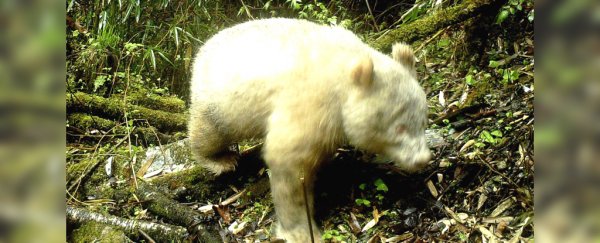The first known sighting of an albino panda has taken place in China, revealing a uniquely pale bear cub padding through a lush green bamboo forest.
This unprecedented vision was not seen directly by human eyes, but was captured by an infrared camera triggered when the panda moved into its motion-activated scopes.
We're lucky it did, because it's given the world our first-ever glimpse of this incredible – and incredibly rare – creature, estimated to still be an infant at only one to two years of age.
Officials at Wolong National Nature Reserve in China's Sichuan province released the image of the giant panda (Ailuropoda melanoleuca) on the weekend, explaining the photo was taken in mid-April by a camera in one of several monitoring plots set up in the reserve to record wildlife activity.
 (Wolong National Nature Reserve)
(Wolong National Nature Reserve)
Albinism is a rare genetic condition that occurs in both humans and animals, disrupting the ability to produce melanin pigmentation in skin.
While the lack of melanin generally makes albinos more susceptible to direct sunlight – and can cause vision problems – it doesn't seem to be greatly disadvantaging this particular cub in its natural habitat. Hopefully, the panda's strange coat won't affect its ability to reproduce either.
"The panda looked strong and its steps were steady, a sign that the genetic mutation may not have quite impeded its life," zoologist and large mammal researcher Li Sheng from Peking University told Chinese state media.
According to the nature reserve, the protected area where the bear was recorded is 2,000 metres (about 6,500 ft) above sea level.
New cameras will now be added to the region to try to increase tracking of this distinctive animal – a scientifically important individual, since an all-white albino panda has never been documented before. (Not all pandas are black-and-white however; the Qinling panda [Ailuropoda melanoleuca qinlingensis] is a rare brown-and-white subspecies.)
While the Wolong animal's sex hasn't yet been determined from the image, the photo does appear to reveal the distinctive reddish eyes of albinism – and of course the luxuriant all-white fur, which presumably makes the panda stand out to other inhabitants in the reserve.
Whether that visibility poses a specific problem for the albino panda isn't yet known, but it's fair to say the species has more pressing issues than animal predators.
As it stands, there are estimated to be less than 1,900 pandas remaining in the wild, according to the IUCN Red List, with only 500–1,000 of those animals thought to be mature individuals.
Per the IUCN's most recent assessment, that makes them a 'Vulnerable' species, threatened by a range of environmental dangers that are almost entirely human-caused.
While numbers are thought to have been increasing in recent years, there's still a huge amount of concern for this beautiful species – and now also for its newest known member, a creature that's rare even among their rare, solitary kind, making it a wonder we glimpsed it at all.
"I personally think it's quite random for it to be discovered, since albinism manifests itself so infrequently," Li told The New York Times.
"This was recorded just in time."
